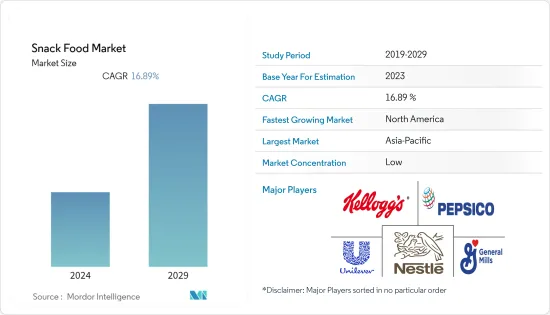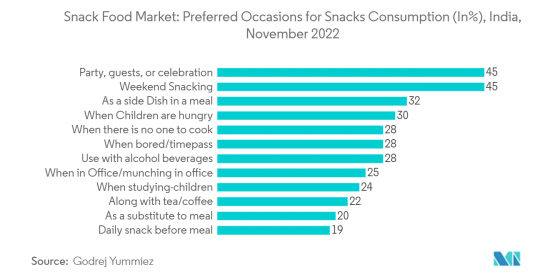 |
市場調査レポート
商品コード
1403872
スナック食品:市場シェア分析、産業動向と統計、2024~2029年の成長予測Snack Food - Market Share Analysis, Industry Trends & Statistics, Growth Forecasts 2024 - 2029 |
||||||
● お客様のご希望に応じて、既存データの加工や未掲載情報(例:国別セグメント)の追加などの対応が可能です。 詳細はお問い合わせください。
| スナック食品:市場シェア分析、産業動向と統計、2024~2029年の成長予測 |
|
出版日: 2024年01月04日
発行: Mordor Intelligence
ページ情報: 英文 184 Pages
納期: 2~3営業日
|
- 全表示
- 概要
- 目次
スナック食品市場規模は2024年の2,562億6,000万米ドルから2029年には6,537億2,000万米ドルに成長し、予測期間中(2024~2029年)のCAGRは16.89%と予測されます。

主要ハイライト
- 消費者は持ち運びが簡単ですぐに手に入る食品を好むため、スナック食品が最良の選択肢となっています。急成長を目の当たりにしたメーカーは、やがてタンパク質、ビタミン、栄養素を強化した製品を発売し、消費者は外出先で間食しながら栄養を摂取できるようになった。消費者が低脂肪、低糖質、高タンパク質のスナック菓子の選択肢を求めた結果、ヘルシーな代替食品が市場に登場しました。人々が食事をスナックに置き換え、スナッキングを通じて適切な栄養を必要としているため、機能性スナッキングは最近重要性を増しています。
- Mondelez Internationalが2021年に発表した間食習慣に関する報告書によると、72%の人がポーションコントロールされた間食を求めています。スナック菓子市場には、チップス、ナッツ、グラノーラバーなど、さまざまな嗜好に対応する多様な製品があります。また、植物由来の食事やクリーンラベルの嗜好が広まるにつれて、天然材料や持続可能な材料から製造されたスナック菓子の需要も高まっています。
- 中期的には、スナック菓子は消費者の行動パターンがパラダイムシフトしたことで、本格的な食事に代わる選択肢として浮上しました。スナック菓子は需要の変化に対応するように進化しており、力をつけた消費者は、おいしくて栄養価が高く持続可能な食品をますます求め、外出の多いライフスタイルの燃料としています。
- 例えば、国際食品情報協議会(International Food Information Council)によると、2023年 5月には米国の消費者の31%が1日1回スナック菓子を食べています。利便性と携帯性への需要が消費を促進し、プレミアム化が新鮮で体に良く機能的なスナックの革新と多様性に拍車をかけているため、スナックは増加傾向にあります。ローカライゼーションは、大胆でスパイシーなフレーバーやエキゾチックな原材料の使用を促し、世界の味覚にアピールすることで、地域市場の成長を促進します。スナック菓子はeコマース・チャネルを通じて購入される食品カテゴリーの上位を占めています。
スナック菓子市場の動向
便利な食品への需要の高まりが市場を牽引
- 現代の消費者は、特に多忙なスケジュールを抱える消費者を中心に、伝統的な食事のために腰を下ろす手助けを頻繁に必要としています。外出中、スナック菓子は食欲を満たし、空腹を抑えるための手軽で便利な選択肢を提供します。核家族の多くは大都市に住んでおり、両親が共働きであるため、子供たちは1日に少なくとも1回は食事をとらずに間食をとる習慣があります。
- スナック菓子は持ち運びしやすいように包装されていることが多く、オフィス、車、公共輸送など、さまざまな場所で食べるのに適しています。コンビニエンスストアや自動販売機があるため、顧客は移動中や都市部でスナック菓子をすぐに手に入れることができます。都会への移住者が増え、スナック菓子を機能的な食事代わりとして利用できる便利な文化が促進され、スナック菓子市場を牽引しています。
- 手軽で、仕事に支障をきたすことなくエネルギーレベルを維持できるため、多くの人が仕事中にスナック菓子を食べています。映画やスポーツ観戦、エンターテインメントのストリーミング視聴、自宅でのパーティーの最中にスナックを食べるのは一般的な習慣です。例えば、Godrej Yummiezが発表したレポートによると、2022年11月、インド人の45%がスナックを消費する機会として、パーティーやお祝いの場を好んでいます。
- 顧客は自宅に居ながらにして、多種多様なスナックをオンラインで閲覧・注文できるため、利便性が大幅に向上しています。Campaign Middle Eastによると、スナック菓子はアラブ首長国連邦で最も急成長しているeコマースカテゴリーであり、2022年の成長率は855%です。

アジア太平洋が最大の市場シェアを占める
- スナック食品は、商業化と都市化が進む発展途上地域で多く消費されています。アジア太平洋は、インドや中国などの新興諸国からの需要が増加しているため、スナック食品市場において最大かつ最速の成長を遂げています。欧米の食習慣が発展途上国に広まり、都市化が進んでいることが、アジア太平洋の発展途上国に進出する世界企業の市場浸透率の向上に役立っています。例えば、インド商工会議所(India Associated Chambers of Commerce and Industry of India)によると、インドにおける組織化された西洋風味スナック菓子の市場規模は2022年に2,420億インドルピーでした。
- 中国のスナック菓子市場は調査期間中に安定した成長を記録しており、予測期間中にさらに改善すると予想されます。さらに、栄養価の高いオン・ザ・ゴー・スナッキングに対する需要の高まりが、同市場における肉系スナックの需要を牽引しています。中国とインドへの観光客の増加が市場拡大を後押ししています。スナックは旅行者や旅行者が旅行中や新しい場所で体験する際に、便利な栄養補給源としてよく利用されます。
- また、タンパク質含有量が高く、脂肪分や炭水化物含有量が低いため、スポーツやフィットネス愛好家の間で需要が高まっています。さらに、中国のスナック・メーカーは健康的なスナック・オプションを革新するために研究開発に注力しています。例えば、2023年4月、広東省東莞市を拠点とするスナックメーカーHsu Fu Chiは、中国の消費者の嗜好の新しい動向をデビューさせるため、華南理工大学と共同で健康的なスナックの研究センターを開発しました。
スナック菓子業界概要
スナック菓子市場は断片化されており、スナック菓子市場の競合は激しく、主に先進国では多数のスナック菓子製造企業が進出しています。スナック菓子市場の大手企業には、PepsiCo Inc.、The Kellogg Company、Unilever Plc、Nestle SA、General Mills Inc.などがあります。
大手企業は、消費者の需要増に対応するための戦略として、新製品開拓、事業拡大、提携、M&Aなどに注力し、市場での競合優位性を獲得しています。市場での支配力を強化するため、これらの企業は香料の革新、対象市場の拡大、流通チャネルの強化に取り組んでいます。また、各社は市場での競争優位性を得るために、製品の提供、品質、味、フレーバー、価格、機能性、サイズ、パッケージング、マーケティング活動など、さまざまな要因で競争しています。
その他の特典:
- エクセル形式の市場予測(ME)シート
- 3ヶ月間のアナリスト・サポート
目次
第1章 イントロダクション
- 調査の前提条件と市場定義
- 調査範囲
第2章 調査手法
第3章 エグゼクティブサマリー
第4章 市場力学
- 市場促進要因
- 便利な食品への需要の高まりが市場を牽引
- 強化スナック食品への需要の高まりが市場を支える
- 市場抑制要因
- 未組織のスナック菓子セクターとマーケティングと流通の課題
- ポーターのファイブフォース分析
- 新規参入業者の脅威
- 買い手/消費者の交渉力
- 供給企業の交渉力
- 代替品の脅威
- 競争企業間の敵対関係の強さ
第5章 市場セグメンテーション
- タイプ
- 冷凍スナック
- セイボリースナック
- フルーツスナック
- 菓子類スナック
- ベーカリースナック
- その他のタイプ
- 流通チャネル
- スーパーマーケット/ハイパーマーケット
- コンビニエンスストア
- 専門店
- オンライン小売店
- その他の流通チャネル
- 地域
- 北米
- 米国
- カナダ
- メキシコ
- その他の北米地域
- 欧州
- スペイン
- 英国
- ドイツ
- フランス
- イタリア
- ロシア
- その他の欧州
- アジア太平洋
- 中国
- 日本
- インド
- オーストラリア
- その他のアジア太平洋
- 南米
- ブラジル
- アルゼンチン
- その他の南米
- 中東・アフリカ
- 南アフリカ
- サウジアラビア
- その他の中東とアフリカ
- 北米
第6章 競合情勢
- 主要企業の戦略
- 市場シェア分析
- 企業プロファイル
- PepsiCo Inc.
- The Kellogg Company
- Nestle SA
- General Mills Inc.
- Mondelez International, Inc
- Conagra Brands Inc.
- Link Snacks Inc.
- Unilever Plc
- Hunter Foods LLC
- Lundberg Family Farms
第7章 市場機会と今後の動向

The snack food market size is expected to grow from USD 256.26 billion in 2024 to USD 653.72 billion by 2029, at a CAGR of 16.89% during the forecast period (2024-2029).
Key Highlights
- Consumers prefer their food to be easy to carry and quickly accessible, making snack food the best option. Witnessing the sudden upsurge, manufacturers eventually launched products enriched with protein, vitamins, and nutrients, giving consumers on-the-go nutrition while snacking. Healthy alternatives have emerged on the market as a result of consumer desire for options for low-fat, low-sugar, and high-protein snacks. Functional snacking is gaining more importance these days as people are replacing their meals with snacks and need proper nutrition through snacking.
- According to the 2021 report of Mondelez International about snacking habits, 72% of people look for portion-controlled snacking options, which means they require their nutrition needs to be fulfilled by snacking. The variety of products available on the snack food market, which cater to a variety of tastes and preferences, includes chips, nuts, granola bars, and more. The demand for snacks produced from natural and sustainable ingredients has also increased as plant-based diets and clean-label preferences have grown in popularity.
- Over the medium term, snack food emerged as an alternative to full-fledged meals with a paradigm shift in consumer behavior patterns. Snacks are evolving to cater to changing demand as empowered consumers increasingly seek tasty, nutritional, and sustainable foods to fuel their on-the-go lifestyles.
- For instance, 31% of consumers in the United States consumed snack food once a day in May 2023, according to the International Food Information Council. Snacking is on the rise as the demand for convenience and portability fuels consumption, with premiumization spurring innovation and variety in fresh, better-for-you, and functional snacks. Localization encourages the use of bold and spicy flavors and exotic ingredients to appeal to global palates, driving growth in the regional markets. Convenience also drives the online sales of ready-to-eat snacks, with snack foods being one of the top food categories purchased through e-commerce channels.
Snack Food Market Trends
Rising Demand for Convenient Foods Drives the Market
- Modern consumers frequently need help to sit down for traditional meals, especially those with busy schedules. While on the go, snack foods offer a quick and convenient option to fulfill appetites and control hunger. Many nuclear families live in big cities, and due to both parents working, the kids have a habit of snacking at least once a day instead of having a whole meal.
- Snacks are often portable and packaged for ease of use, making them appropriate for consumption in a variety of locations, including offices, vehicles, and public transportation. Customers can quickly grab snacks while traveling or in urban areas because of convenience stores and vending machines. More people are moving into cities, which promotes a culture of convenience where snacks can be used as functional meal replacements, driving the snack food market.
- Many people munch while at work since it is handy and keeps their energy levels up without disrupting their work. Consuming snacks while watching films, sporting events, streaming entertainment, and partying at home is a common practice. For instance, 45% of Indians preferred party and celebration occasions for snack consumption in November 2022, according to the report published by Godrej Yummiez.
- Customers can browse and order a large variety of snacks online from the comfort of their homes, greatly boosting convenience. According to the Campaign Middle East, snack food is the fastest-growing e-commerce category in the United Arab Emirates, with a growth rate of 855% in 2022.

Asia-Pacific Holds the Largest Market Share
- Snack food products are largely consumed in developing regions with high commercialization and urbanization. Asia-Pacific represents the largest and fastest-growing market for snack food products owing to increasing demand from developing countries, such as India and China. The spread of Western eating habits to the developing world and growing urbanization have helped improve market penetration for global players entering the developing nations of Asia-Pacific. For instance, the size of the organized Western savory snacks market in India was INR 242 billion in 2022, according to the Associated Chambers of Commerce and Industry of India.
- The Chinese snack food market registered stable growth in the study period, and it is expected to improve further during the forecast period. Moreover, the rising demand for on-the-go snacking with additional nutritional content is driving the demand for meat-based snacks in the market. Rising numbers of tourists to China and India fuel market expansion. Snacks are a common source of convenient sustenance for tourists and travelers while on trips or while experiencing new places.
- Additionally, the higher protein content and lower fat and carb contents of products augment their demand among sports and fitness enthusiasts. Furthermore, Chinese snack manufacturers are focusing on research and development to innovate healthy snack options. For instance, in April 2023, Dongguan, Guangdong province-based snack maker Hsu Fu Chi, collaborated with the South China University of Technology to develop a healthy snack research center to debut new trends in Chinese consumer preferences.
Snack Food Industry Overview
The Snack Food market is fragmented, and the competition in the snack food market is high, mostly in developed countries, where a large number of snack food manufacturing companies are operating. Some of the major players in the snack food market are PepsiCo Inc., The Kellogg Company, Unilever Plc, Nestle SA, and General Mills Inc.
The prominent players are focusing on new product developments, expansions, partnerships, and mergers and acquisitions as strategies to cater to the increasing demand from consumers, thereby gaining a competitive advantage in the market. To strengthen their hold in the market, these companies are innovating their flavors, expanding their target markets, and strengthening their distribution channels. Also, companies compete on different factors, including product offerings, quality, taste, flavors, price, functionality, size, packaging, and marketing activities, to gain a competitive advantage in the market.
Additional Benefits:
- The market estimate (ME) sheet in Excel format
- 3 months of analyst support
TABLE OF CONTENTS
1 INTRODUCTION
- 1.1 Study Assumptions and Market Definition
- 1.2 Scope of the Study
2 RESEARCH METHODOLOGY
3 EXECUTIVE SUMMARY
4 MARKET DYNAMICS
- 4.1 Market Drivers
- 4.1.1 Rising Demand for Convenient Foods Drives the Market
- 4.1.2 Growing Demand for Fortified Snack Food Supports the Market
- 4.2 Market Restraints
- 4.2.1 Unorganized Snack Sector, Coupled With Marketing And Distribution Challenges
- 4.3 Porter's Five Forces Analysis
- 4.3.1 Threat of New Entrants
- 4.3.2 Bargaining Power of Buyers/Consumers
- 4.3.3 Bargaining Power of Suppliers
- 4.3.4 Threat of Substitute Products
- 4.3.5 Intensity of Competitive Rivalry
5 MARKET SEGMENTATION
- 5.1 Type
- 5.1.1 Frozen Snacks
- 5.1.2 Savory Snacks
- 5.1.3 Fruit Snacks
- 5.1.4 Confectionery Snacks
- 5.1.5 Bakery Snacks
- 5.1.6 Other Types
- 5.2 Distribution Channel
- 5.2.1 Supermarkets/Hypermarkets
- 5.2.2 Convenience Stores
- 5.2.3 Specialty Stores
- 5.2.4 Online Retail Stores
- 5.2.5 Other Distrbution Channels
- 5.3 Geography
- 5.3.1 North America
- 5.3.1.1 United States
- 5.3.1.2 Canada
- 5.3.1.3 Mexico
- 5.3.1.4 Rest of North America
- 5.3.2 Europe
- 5.3.2.1 Spain
- 5.3.2.2 United Kingdom
- 5.3.2.3 Germany
- 5.3.2.4 France
- 5.3.2.5 Italy
- 5.3.2.6 Russia
- 5.3.2.7 Rest of Europe
- 5.3.3 Asia-Pacific
- 5.3.3.1 China
- 5.3.3.2 Japan
- 5.3.3.3 India
- 5.3.3.4 Australia
- 5.3.3.5 Rest of Asia-Pacific
- 5.3.4 South America
- 5.3.4.1 Brazil
- 5.3.4.2 Argentina
- 5.3.4.3 Rest of South America
- 5.3.5 Middle East and Africa
- 5.3.5.1 South Africa
- 5.3.5.2 Saudi Arabia
- 5.3.5.3 Rest of Middle East and Africa
- 5.3.1 North America
6 COMPETITIVE LANDSCAPE
- 6.1 Strategies Adopted By Leading Players
- 6.2 Market Share Analysis
- 6.3 Company Profiles
- 6.3.1 PepsiCo Inc.
- 6.3.2 The Kellogg Company
- 6.3.3 Nestle SA
- 6.3.4 General Mills Inc.
- 6.3.5 Mondelez International, Inc
- 6.3.6 Conagra Brands Inc.
- 6.3.7 Link Snacks Inc.
- 6.3.8 Unilever Plc
- 6.3.9 Hunter Foods LLC
- 6.3.10 Lundberg Family Farms
